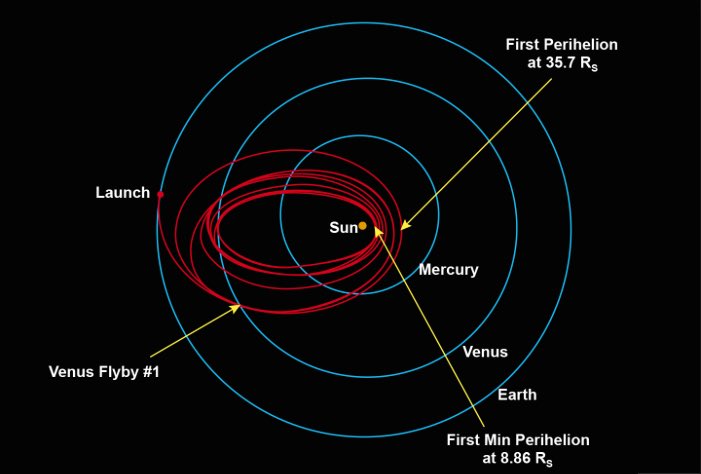 |
|
Illustration of NASA’s
Parker Solar Probe passing Venus on Oct. 3, 2018 at a distance of 1500 miles (2400 km) above the surface. Credit: NASA/Johns Hopkins APL/Steve Gribben |
KENNEDY SPACE CENTER, FL –
NASA’s Parker Solar Probe completed its first flyby of the planet Venus early
today, a critical maneuver that curved the spacecrafts path and slowed the speed
sufficiently to fly by and ‘touch’ the sun very soon!
In early November, the $1 Billion NASA science probe will journey
closer than any spacecraft in human history and carry out its mission to ‘touch
the sun.’
The car sized Parker successfully barreled past Venus at
about 4:45 a.m. EDT Wednesday. Oct. 3 – barely 1500 miles (2400 km) above the surface.
“Parker Solar Probe successfully completed its
flyby of Venus at a distance of about 1,500 miles during the first Venus
gravity assist of the mission,” NASA reported in a statement today.
planned through the mission which is expected to last through 2024.
“These gravity assists will help the
spacecraft tighten its orbit closer and closer to the Sun over the course of
the mission.”
The flyby also reduced Parker speed relative
to the sun by about 7000 MPH and placed it on a trajectory 4 million miles
closer.
“On Oct. 3,
2018, Parker Solar Probe performed the first significant celestial maneuver of
its seven-year mission. As the orbits of the spacecraft and Venus converged
toward the same point, Parker Solar Probe slipped in front of the planet,
allowing Venus’ gravity — relatively small by celestial standards — to twist
its path and change its speed.”
“This
maneuver reduced Parker’s speed relative to the Sun by 10 percent — amounting
to 7,000 miles per hour — drawing the closest point of its orbit, called
perihelion, nearer to the star by 4 million miles.”
 |
|
Parker Solar Probe Mission
Trajectory and Current Position after Venus flyby Oct 4, 2018. Credit: NASA/APL/Parker Solar Probe |
Mission scientists and engineers are now analyzing the data
to confirm all went exactly as planned.
“Detailed data from the flyby will be assessed
over the next few days. This data allows the flight operations team to prepare
for the remaining six Venus gravity assists which will occur over the course of
the seven-year mission.”
The team is also working 24/7 to checkout and
calibrate the four on board science instruments.
The calibration and checkout data to date demonstrate
that “each of the instruments is working well” says NASA.
For example, the ‘first light’ image below was
captured by the WISPR instrument, short
for the Wide-field Imager on Parker Solar Probe, on Sept. 9,
2018.
They must be on line before the 1st
solar encounter period begins on Oct. 31 and lasts through Nov. 11.
5.
In the meantime, it gets closer and closer!
On Oct. 29, Parker Solar Probe is slated to approach within 27 million miles (43 million km)
of the Sun- surpassing the current record
held by the German American Helios 2 mission set in 1976.
On Oct. 30, the
probe will “surpass a heliocentric
speed of 153,454 miles per hour” according to NASA.
“This is the record for fastest spacecraft
measured relative to the Sun, set by Helios 2 in 1976.”
The mission began with a dazzling
middle-of-the-night blastoff of the mighty Delta IV Heavy rocket in the wee
hours of Sunday morning, Aug. 12 – and delivered the car sized spacecraft to its
intended trajectory towards Venus and the Sun.
The 23-story tall triple barreled United
Launch Alliance Delta IV Heavy rocket successfully launched at 3:31 a.m. EDT
Aug. 12 from the Florida Space Coast and put on a brilliant display of fire
power with 2.1 million pounds of thrust spewing forth from the trio of liquid
oxygen/liquid hydrogen RS-68A main engines that quickly turned night into day a
few hours before Sundays natural sunrise under nearly cloud-free skies.
Check out our Space UpClose gallery of photos
and videos. Plus my BBC TV World News prelaunch interview.
Here’s my Parker launch video
from a remote camera set at pad 37:
Delta IV Heavy rocket on Aug. 12, 2018, at 3:31 a.m. EDT from Launch
Complex 37 at Cape Canaveral Air Force Station, Florida on humanity’s 1st
mission to our sun that will fly through the sun’s atmosphere or corona – as seen in this remote camera video taken at the pad. Credit:
Ken Kremer/kenkremer.com/spaceupclose.com
Pre-Launch interview:
Watch for Ken’s continuing onsite coverage of NASA, SpaceX, ULA,
Boeing, Lockheed Martin, Orbital ATK and more space and mission reports direct
from the Kennedy Space Center, Cape Canaveral Air Force Station, Florida and
Wallops Flight Facility, Virginia.
Stay tuned here for Ken’s continuing Earth and Planetary science and human
spaceflight news: www.kenkremer.com
–www.spaceupclose.com – twitter @ken_kremer – email: ken at kenkremer.com
Dr. Kremer is a research scientist and journalist based in the
KSC area
.……….
Ken’s photos are for sale and he is available for lectures and outreach events
 |
|
The orbit design for
the Parker Solar Probe mission illustrating the trajectory through the inner solar system following Aug. 12, 2018 launch from Cape Canaveral, FL. Credit: NASA/Johns Hopkins APL |




